
A peek at the inner bark, Lady Bird Johnson Grove Trail, Redwood National and State Parks / Rebecca Latson
A visit to a national park is more than just getting the shot. Sure, whenever I travel to a national park, I capture photos of landscapes and wildlife. But, I also take pictures of things that interest me and about which I know nothing, but would like to know something.
Take the image above, for instance. I saw this parting of the outer bark on a redwood tree while hiking the Lady Bird Johnson Grove Trail in the Redwood National Park portion of Redwood National and State Parks, in Northern California. The image reminded me of a thick, red-brown curtain parting to show me a portion of the tree I’d never viewed before. And, seeing that inner portion of different-colored bark prompted me to get a photo so I could look it up later. FYI, that light colored bark is called the “secondary phloem,” (pronounced flow-em) which is the outside portion of the tree’s cambium layer (aka “inner bark”).
Photography not only builds your observation skills and tells a story, but can also teach both photographer and viewer about what is framed within the composition. For this month’s column, I thought I’d post some shots I’ve captured of things that interested me at the time of my park visit, and prompted me to learn more about those things. I hope this not only teaches you about something you might not have known, but will spur you to look a little closer at, and learn a little more of, your surroundings whenever you wander around a National Park System unit with your camera.
Redwood National and State Parks (California)

A goose pen, Lady Bird Johnson Grove Trail, Redwood National and State Parks / Rebecca Latson
Goose Pen – I’d seen these triangular, hollow openings within a number of redwood trees, but didn’t know they actually had a name until I parked next to a tree on the side of the road with a placard explaining the phenomenon. Back in the day, settlers used these openings as pens in which to keep their geese corralled. Now, this particular goose pen wouldn’t work so well because of the openings all around the tree, but you do get the idea.
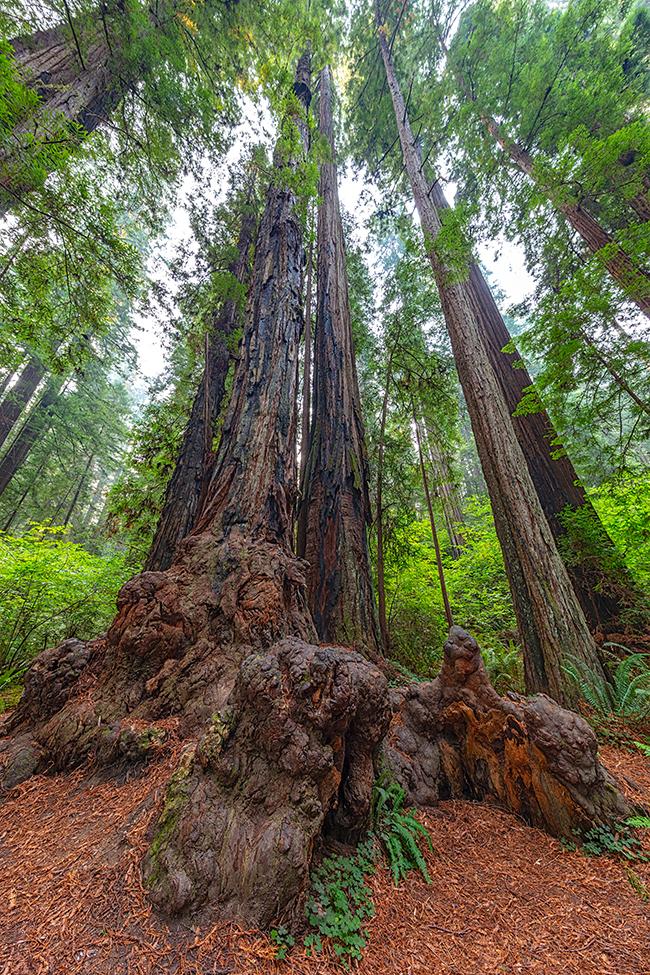
Burls at the base, Stout Grove Trail, Jedediah Smith Redwoods State Park,Redwood National and State Parks / Rebecca Latson
Burls – According to the National Park Service, a “burl is the knobby growth most commonly seen at base of some coast redwoods, though it can also be found high in the canopy as well. Burl is a woody material full of unsprouted bud tissue. It serves as a storage compartment for the genetic code of the parent tree. If the redwood falls or is damaged, the burl may sprout another redwood tree known as a clone.” As you wander the redwood groves, you might notice two or more redwoods growing so close to each other as to be within a couple of inches of touching. Or, you might notice two redwoods literally joined at the hip – er – base of the trunk. More than likely, one of those trees sprouted from a burl at the base of the other tree.
Bryce Canyon National Park (Utah)

A rainy summer day over Bryce Amphitheater, Bryce Canyon National Park / Rebecca Latson
Bryce Amphitheater – The name Bryce “Canyon” is a bit of a misnomer. What you see is not a canyon but, rather, a series of natural amphitheaters (bowl-shaped areas) created from erosion into the Paunsaugunt Plateau by “seasonal rains and melting snow.” Think of those images you’ve seen online and in textbooks of ancient Roman amphitheaters – oval-shaped, open-air theaters with raised tier seating. What you see here is created not by man, but by nature. If you are there with your camera, then you will, at some point, probably capture a wide-angle image displaying that amphitheater shape, which is especially noticeable when standing at Sunrise Point or at Inspiration Point, looking into Bryce Amphitheater.
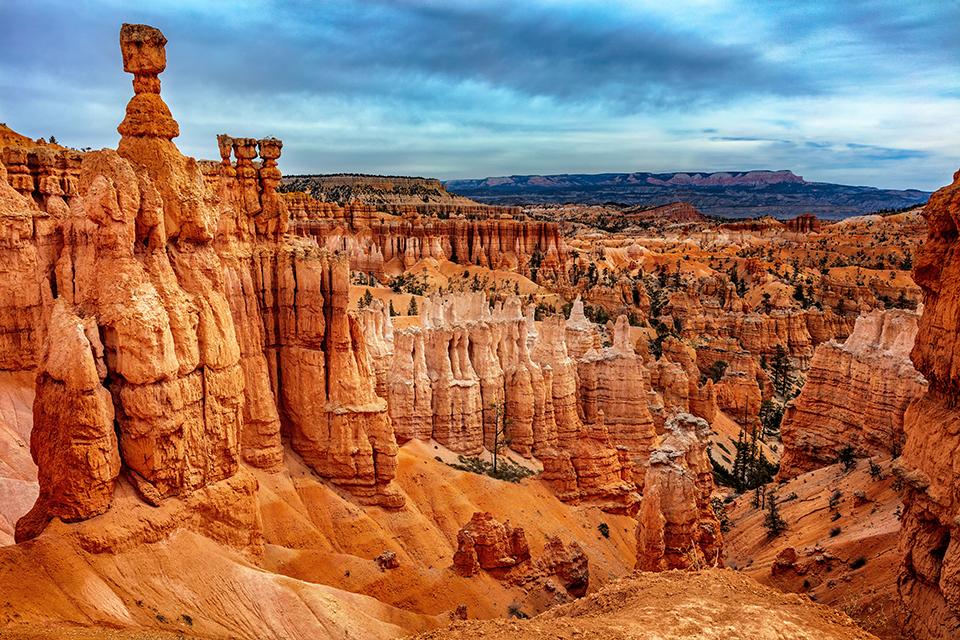
An overcast day over the hoodoos, Bryce Canyon National Park / Rebecca Latson
Hoodoos – This national park has some of the most surreal geological formations I’ve seen. You can view spires, towers, arches, and hoodoos, all created from that crumbly-looking pink/orange rock that’s a part of the Claron Formation. So, what exactly are hoodoos? They are spires of eroded soft rock typically topped by a harder, less easily eroded stone. They sort of look like totem poles, with their uneven outlines.
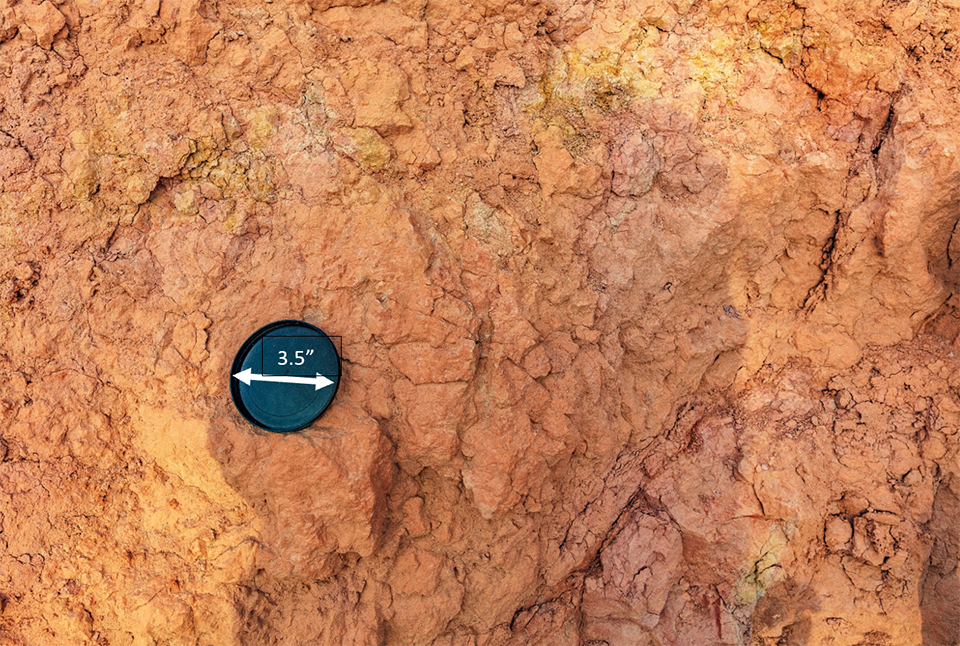
Crumbly looking rock, Bryce Canyon National Park / Rebecca Latson
Because I was curious as to how crumbly that rock might be, I photographed a close-up of the rock using a lens cap for scale. While it may look easy to break off, but I can tell you it’s truly hard as rock (pun intended). To read a more detailed explanation of the formation of Bryce Canyon’s hoodoos, click here.
Olympic National Park (Washington)

Licorice ferns and other epiphytes on a big leaf maple, Hoh Rain Forest, Olympic National Park / Rebecca Latson
Epiphytes – Part and parcel with the Hoh and Quinault rain forests in Olympic National Park are all the mosses and lichens you see growing on the ground, on rocks, and on trees. “Mosses not only lack true leaves, stems, and roots, but they also lack the protective outer cuticle most other plants have.” The mosses and ferns you see growing on trees are called epiphytes, which are plants that grow on other plants but which are not parasitic.

Tilted beds at Kalaloch Beach 4, Olympic National Park / Rebecca Latson
Tilted Beds And An Unconformity - This national park on the Olympic Peninsula also has some pretty interesting geology, and you can see evidence of that right on Kalaloch Beach 4, about 3 miles north of Kalaloch Lodge. Walk down the trail from the parking area and you’ll come to a short wood bridge before climbing down to the beach. As soon as you land on the sand, turn around to view the tilted sedimentary rocks known as the Hoh Assemblage. Laying on top of these tilted rocks is a layer of alpine glacial gravel deposited there by running water. That dividing line, or contact, between the younger, level layer of glacial outwash overlaying the older tilted beds is called an unconformity, which represents a break in time between the older, tilted sediments and the younger glacial outwash. In the photo here, you are looking at an angular unconformity because of the tilted beds.
Petrified Forest National Park (Arizona)
Those petrified logs are the stars of the show in this national park. As I photographed them, a couple of questions came to mind: what makes up all those colors I see in these logs, and why do they look like segments neatly sawed off? To understand those questions, you first need to understand how trees living millions of years ago in a then-swampy landscape became petrified.
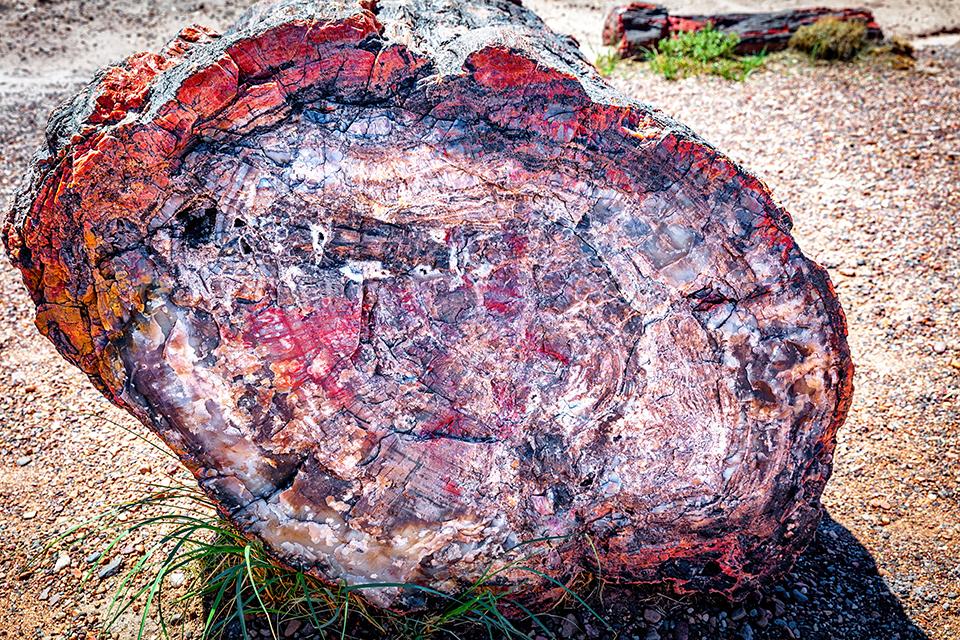
Colors in the silica of a petrified log, Petrified Forest National Park / Rebecca Latson
Petrified Log Colors - “Over 200 million years ago, the logs washed into an ancient river system and were buried quick enough and deep enough by massive amounts of sediment and debris also carried in the water, that oxygen was cut off and decay slowed to a process that would now take centuries. Minerals, including silica dissolved from volcanic ash, absorbed into the porous wood over hundreds and thousands of years crystallized within the cellular structure, replacing the organic material as it broke down over time. The rainbow of colors is produced by impurities in the quartz, such as iron, carbon, and manganese.”
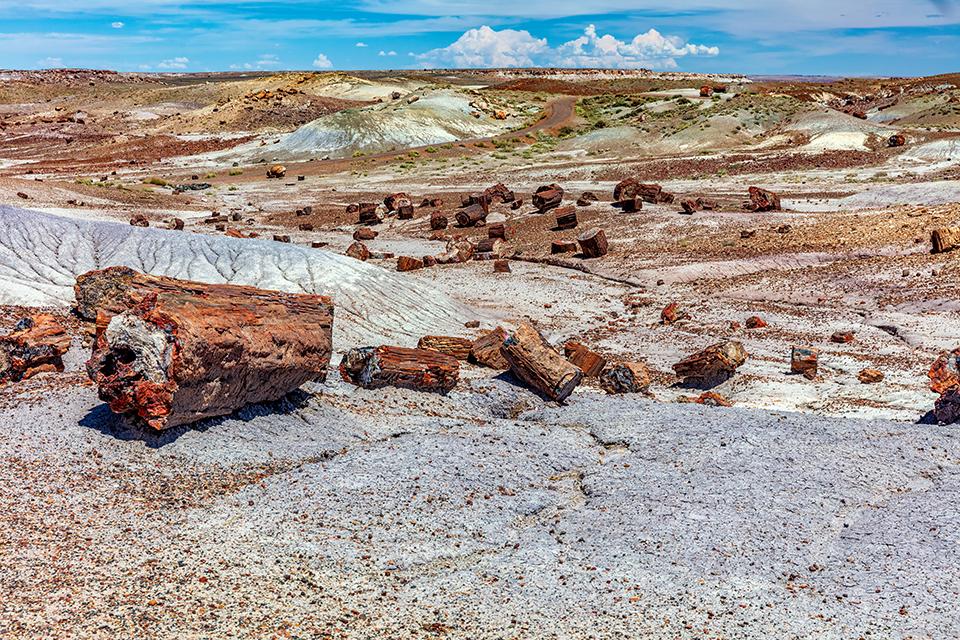
Petrified log segments along the Crystal Forest Trail, Petrified Forest National Park / Rebecca Latson
Log Segmentation - “The logs are very hard (7.8 on the 1-10 Mohs hardness scale!), but brittle. After petrification, but while the logs were still encased in matrix rock, the logs cracked under stress. As the logs eroded out, from gravity and ice wedging, the cracks widened and segments separated. Silica naturally breaks on a clean angle.”
Yellowstone National Park (Wyoming, Montana, Idaho)

Thermophilic bacteria colors, Yellowstone National Park / Rebecca Latson
Cyanobacteria Mats - While still on the subject of colors in nature, let’s go to Yellowstone National Park. As you wander the boardwalks over the various geyser basins, you’ll notice boiling water leaving orange, brown, and yellow trails over the ground as they flow from various hot springs and geysers. Those colors in the water come from heat-loving (thermophilic) bacteria known as cyanobacteria. These simple life forms create long strands or paper-thin mats within the hot water, such as the example you see in the photo, which was captured using a telephoto lens and then cropped for an even closer look. To learn more about thermophilic bacteria, click here.

The colors of a hot spring at Biscuit Basin, Yellowstone National Park / Rebecca Latson
Hot Spring Colors - Many hot springs you see, like Grand Prismatic, Morning Glory Pool, and other unnamed springs like the one pictured here have lovely layers of colors within the hot water. Thermophilic microorganisms create the various blue, green, yellow and orange water colors, each of which indicates a different water temperature. “Yellowstone's hot water systems often show distinct gradations of living, vibrant colors where the temperature limit of one group of microbes is reached, only to be replaced by a different set of thermophiles.” Remember, every bit of that water is hot (not to mention either highly acidic or highly alkaline), so stay on the boardwalk and don’t ever try to touch or soak in any of those hot springs. To learn more about Yellowstone’s hot springs, click here.
Big Bend National Park (Texas)

An ocotillo in the desert, Big Bend National Park / Rebecca Latson
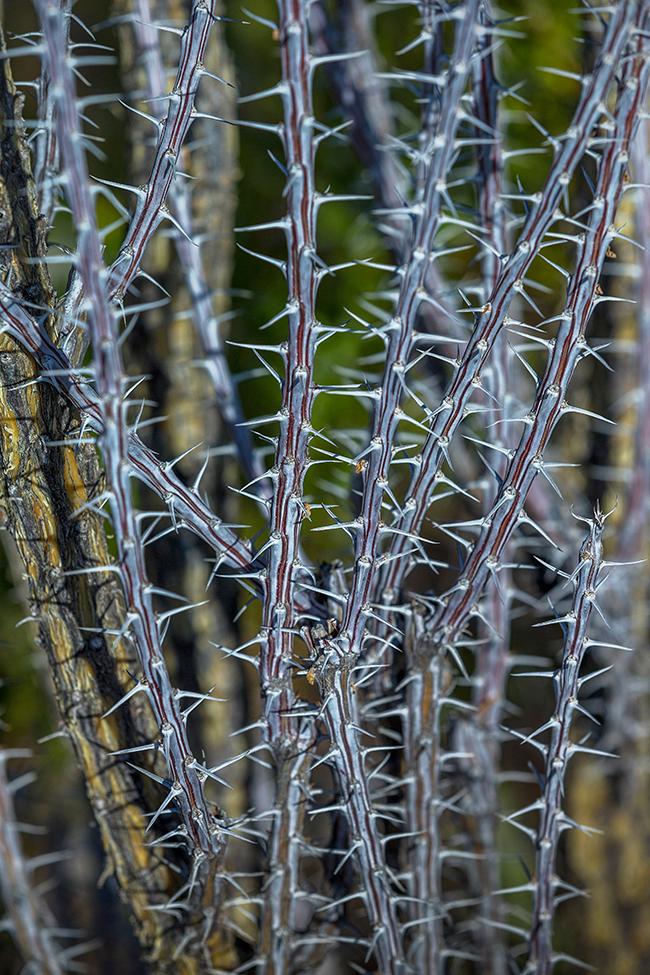
Evil-looking ocotillo thorns, Big Bend National Park / Rebecca Latson
Ocotillo - In my photographic opinion, the best time to visit this national park in Texas is during late March through May, when the cactus are in bloom. Not only did the blooms captivate me, but the entire cactus structure piqued my interest. Especially this one particular “cactus,” with its long, spindly arms ridden with evil-looking thorns and tipped with tiny, bright orange-red tubular flower clusters. Because I wanted to know more about this particular “cactus,” I captured both overall and close-up shots. Turns out, this “cactus” is really a plant called ocotillo, a type of shrub belonging to the family Fouquieriaceae ( Cactus belong to the family Cactaceae). And those long, spindly branches on an ocotillo are called “canes.” Ocotillo has many different names (coachwhip, candlewood, slimwood, Jacob’s staff) and they’ve even been used as fences because those thorny canes make great deterrents.
Ok, I’ll stop here with the photographic fun facts, but you’ll see more of these articles throughout the year. I’ve learned many things through the photos I’ve captured while visiting national parks, and you can do the same with your own cameras.

The author and a goose pen, Prairie Creek Redwoods State Park, Redwood National and State Parks / Rebecca Latson
References
In addition to the information taken from the websites for each park, I also used the following for references.
https://www.nps.gov/redw/planyourvisit/upload/Redwood_Burl_Final-508.pdf
https://www.maximumyield.com/definition/1874/secondary-phloem
https://www.brycecanyon.com/bryce-canyon-geology/



Comments
Wonderful presentation-- mother nature delights and puts fear in us- WILDFIRES wildly spreading with man inferior to wind & flame until rain, or snow, aids him. Picture 1 , can be from a lightning strike opening cambium